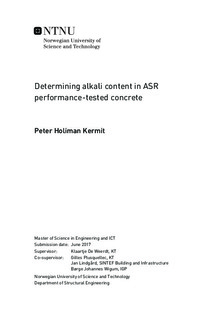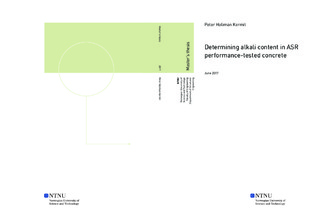| dc.description.abstract | Alkali silica reation (ASR) is a common deterioration mechanism of concrete. During ASR, reactive aggregate containing silicon oxide (SiO2) can react with the alkaline fluid in the concrete pores. To test whether a concrete mix is prone to ASR, several concrete prism tests (CPT) are developed. Performance tests are defined as a CPT where the alkali content in the concrete is comparable to that of a conventional concrete. During CPT, leaching or ingress of alkalis can affect the result of the test, as proven by Lindgård et al. (2013b). However, Lindgård measured leaching and ingress by testing the leachate, lining and wrapping in the test container for alkali, but not the prisms themselves.
In my master thesis project, I have investigated four concrete prisms that have been tested with different concrete prism performance tests. The prisms had experienced different degrees of leaching or ingress according to Lindgårds measurements. The prisms were cut and ground to give concrete powder samples that I tested using cold water extraction (CWE) and hot acid extraction (HAE). Aggregates were also ground and tested with these methods to account for alkali contribution from the aggregates during CWE and HAE. All samples were tested with thermogravimetric analysis (TGA) to investigate the paste content. CWE and HAE produced solutions which were measured for alkali content using inductively coupled plasma mass spectrometry (ICP-MS). The results were compared to the expected alkali content in the prisms given from the alkali content in the cement from the recipe, minus the measured leaching or ingress. I have investigated all measurements and calculations, and calculated the error based on these. The calculations of errors are based on the principle of error propagation, and I assume all errors are uncorrelated.
My results show that HAE is not suitable for measuring total alkali content. CWE does not measure the expected 50-60% of the expected alkali content, but gives consistent results that are not affected by contribution from the aggregates. Free alkali content measured CWE has low errors. Leaching and ingress is indicated in the bulk samples, but the ground profiles does not give any conclusive evidence because of alkali redistribution due to drying. However, transportation of alkali from the top of the prisms to the bottom is indicated, aswell as leaching in the top and bottom surfaces of the prisms. Because I have not been able to measure the total alkali content, I am not able to prove alkali release from aggregates, due to HAE not being able to measure total alkali content. For a future study XRF should be used for this. | |

